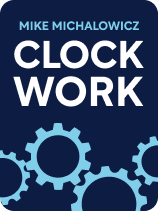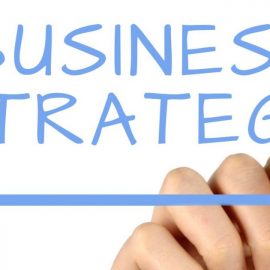

This article is an excerpt from the Shortform book guide to "Clockwork" by Mike Michalowicz. Shortform has the world's best summaries and analyses of books you should be reading.
Like this article? Sign up for a free trial here.
What is Mike Michalowicz’s Clockwork about? What is the key message to take away from the book?
In his book Clockwork, Mike Michalowicz presents a process entrepreneurs can follow to become hands-off visionaries. A hands-off entrepreneur trains her employees to take care of the hands-on work instead of overseeing the daily operations herself.
Below is a brief overview of Clockwork: Design Your Business to Run Itself by Mike Michalowicz.
Clockwork: Design Your Business to Run Itself
For most small business owners, taking a four-week vacation is inconceivable. Overwhelmed with the hands-on work of running their company’s daily operations, many entrepreneurs feel too burned out to achieve work-life balance—let alone take a vacation.
However, in his book Clockwork, entrepreneur Mike Michalowicz claims a four-week vacation is within reach for small business owners. To achieve it, they must abandon their typical, hands-on approach to leading their business. He argues that entrepreneurs can avoid burnout, achieve work-life balance, and revitalize their businesses by committing to a hands-off approach. This enables the entrepreneur to instead play the role of visionary, a role which suits their entrepreneurial spirit and offers the luxury of ample time off.
Michalowicz is an entrepreneur and the author of seven books on entrepreneurship, including Profit First. His ideas in Clockwork stem from his experience becoming a hands-off business owner and coaching other entrepreneurs to do the same. He writes primarily for an audience of small business owners with multiple employees. However, some of his ideas on work-life balance and taking a hands-off approach to work are relevant to anyone seeking to avoid burnout.
We’ll begin this guide by exploring why entrepreneurs are prone to burnout. Then, we’ll turn to solutions by presenting Michalowicz’s steps for becoming a hands-off entrepreneur with a healthy work-life balance. Throughout this guide, we’ll compare his ideas to those of other business experts, such as Gino Wickman, Jocko Willink, and Leif Babin. We’ll also supplement the author’s strategies with additional actionables, such as how to prevent your employees from burning out.
The Problem: Entrepreneur Burnout
According to Michalowicz, burnout plagues many entrepreneurs. Burnout is when stress drains you of your physical, emotional, and mental energy. Over time, burnout leaves entrepreneurs too depleted to run a successful business. We’ll begin this section by understanding why so many entrepreneurs burn out. Then, we’ll explore why entrepreneurs’ usual solution to burnout—maximizing their productivity—doesn’t actually help.
Why Entrepreneurs Suffer From Burnout
Michalowicz argues that entrepreneurs suffer from burnout because they run their businesses using a hands-on approach. Hands-on entrepreneurs involve themselves in most aspects of their company’s daily operations. This includes everyday tasks (such as corresponding with customers) and related decisions (such as when to proactively contact customers). Even entrepreneurs who delegate daily tasks to their employees are hands-on, since these entrepreneurs still make most of the decisions behind those tasks.
(Shortform note: Research reveals that entrepreneurs experience a unique form of burnout, partly due to the stress of making too many decisions. This finding supports Michalowicz’s claim that a hands-on approach (which entails making many decisions) contributes to entrepreneur burnout. Entrepreneur burnout tends to manifest in the body and persist beyond work hours. Burned-out entrepreneurs typically experience both physical exhaustion and difficulty thinking clearly. By contrast, employee burnout tends to show up during work hours. Burned-out employees feel unmotivated to do their best work and disconnected from colleagues.)
Why Entrepreneurs Burn Themselves Out With a Hands-On Approach
Michalowicz argues that entrepreneurs default to a hands-on approach because it feeds their self-esteem. When they handle daily operations and related decisions, they feel essential to their company’s success. Feeling essential boosts their self-esteem.
(Shortform note: In Traction, Gino Wickman claims that entrepreneurs entwine their self-esteem with their business (and maintain a hands-on approach) because they see their company as an extension of their identity. In order to grow their company beyond its early stages, entrepreneurs must abandon this notion and reduce their hands-on involvement.)
Although a hands-on approach boosts self-esteem, Michalowicz argues that this approach also burns entrepreneurs out by distracting them from improving their business framework. A business framework includes the company’s mission, employee roles, and routines for measuring and modifying daily operations. When entrepreneurs busy with hands-on work neglect to improve their company framework, small issues grow into crises.
When small issues grow into crises, an entrepreneur enters crisis mode: They work long hours to address crises on top of their usual hands-on duties. Crisis mode burns them out, leaving them ill-equipped to fully resolve these crises. Eventually, the burned-out entrepreneur loses their motivation for running their business.
To illustrate, consider this hypothetical small issue: There’s a slight decline in the number of customers who enter your company’s store. If you’re not absorbed in hands-on work, you could improve your business framework by researching and designing novel ways to attract new customers (such as promoting your business on social media). By contrast, if you’re immersed in hands-on work, you’d be too busy to make these improvements. Eventually, the small issue would swell into a crisis: a long-term or sharp decline in customers. You’d enter crisis mode as you scramble to resolve this larger issue, burning yourself out.
(Shortform note: While Michalowicz emphasizes how a hands-on approach harms entrepreneurs by burning them out, other experts illustrate how a hands-on approach also harms your employees and your relationships with them. Jocko Willink and Leif Babin, authors of The Dichotomy of Leadership, argue that when your employees notice your overinvolvement in daily operations, they become passive. Instead of innovating and developing independence, they wait for you to assign them tasks. Over time, their passive role demotivates them and limits their growth. In Ego is the Enemy, Ryan Holiday adds that a hands-on approach can breed resentment among your employees because they may find your overinvolvement domineering.)
Why Productivity Tricks Fail to Fix Burnout
Next, we’ll explore how entrepreneurs typically try to fix their burnout—and why it fails. Michalowicz argues that entrepreneurs misdiagnose burnout as a productivity problem, rather than a result of their hands-on approach. They mistakenly believe burnout is a productivity problem because an abundance of books and apps promise to help them organize their day, work more efficiently, and avoid distraction. These resources give entrepreneurs the impression that they’re burned out because they’re not productive enough.
(Shortform note: Despite Michalowicz’s claim that productivity apps don’t address the true problem of hands-on entrepreneurship, it’s likely productivity tricks will continue to entice entrepreneurs in the future: Experts predict that the global market for productivity apps will continue growing at an average annual rate of 9.1% over the next 10 years.)
Let’s explore two reasons why productivity tricks fail to alleviate entrepreneur burnout.
Reason 1: Productivity Tricks Don’t Reduce Your Work Hours
First, Michalowicz argues that productivity tricks fail to fix burnout because they train you to work more efficiently instead of working less. With both routine, hands-on tasks and crises to manage, hands-on entrepreneurs always have more work than they can squeeze into their days. Even if they learn to maximize their efficiency, they continue to fill their schedules with these additional tasks. Entrepreneurs don’t need support working more efficiently; they need support working less.
(Shortform note: Entrepreneurs aren’t the only people who tend to pack their schedules with work. In Four Thousand Weeks, Oliver Burkeman argues that all people living in industrialized societies engage in this habit because our society values productivity over free time. He looks to history to explain why: During the Industrial Revolution, business owners began treating workers’ free time as a means to an end. These business owners provided workers with free time only so they returned to work recharged and ready to be maximally efficient. This emphasis on free time as a strategy for increasing productivity, rather than as something to enjoy, still persists today.)
Reason 2: Productivity Tricks Don’t Prevent Crises
Second, Michalowicz claims that productivity tricks fail to fix burnout because they don’t prevent crises. As previously noted, crises emerge when entrepreneurs busy with hands-on work neglect to address fractures in their business framework. Productivity tricks may teach entrepreneurs to handle crises more efficiently, but they don’t teach you how to prioritize designing a framework that prevents crises from arising in the first place.
The Solution: Become a Hands-Off Visionary
Instead of wasting their time on productivity tricks, entrepreneurs need a solution to burnout that addresses its real cause: their hands-on approach. Michalowicz argues that entrepreneurs can avoid burnout and revitalize their businesses by becoming hands-off visionaries. This type of entrepreneur is hands-off because they train their employees to independently handle daily operations. They’re visionaries because their role is to keep an eye on their company’s issues, envision new possibilities, and make improvements to their company’s framework.
(Shortform note: In The Dichotomy of Leadership, authors Willink and Babin argue that a hands-off approach works for any form of leadership. Like Michalowicz, they advocate for an approach in which you empower your team to assume greater responsibility so you can focus on overseeing big-picture concerns. Their argument that this style works for any type of leadership suggests that you can practice a hands-off approach and accelerate your mastery of it in areas of your life beyond your business. For example, practice using a hands-off approach when organizing a family reunion by delegating tasks to other family members.)
A hands-off approach offers an entrepreneur three advantages over a hands-on approach:
- An escape from crisis mode. Whereas a hands-on entrepreneur reacts to crises, a hands-off visionary proactively prevents crises by mending fractures in their company framework before they worsen. Hands-off visionaries have time to proactively prevent crises because their employees handle daily operations.
- Better work-life balance. While building and fixing the company’s framework is important, it’s less time-sensitive than hands-on work and crisis management. Since their work is less urgent, a hands-off visionary has the flexibility to decide when and how much to work.
- Renewed motivation. Free from crisis mode and a constraining schedule, hands-off visionaries have the mental, physical, and emotional energy to revitalize their business.
In the next section, we’ll outline Michalowicz’s process for transitioning from a hands-on entrepreneur to a hands-off visionary. We’ve organized this process into three phases. Throughout these phases, we’ll illustrate the author’s concepts with this example: You own a company called Storyline.
Phase 1: Build a Framework That Emphasizes Motivation
Michalowicz shares that the first phase of becoming a hands-off entrepreneur is building a business framework that emphasizes motivation. A motivating framework prepares you to become a hands-off visionary because it inspires you to revitalize your business and motivates your employees to work independently. In this section, we’ll describe three goals you can work toward to achieve a motivating business framework.
Goal 1: Determine Your Mission
First, Michalowicz claims that you must identify your mission: an ambition that both delights you and improves others’ lives. This mission must delight you so you look forward to working. Furthermore, the promise of improving others’ lives will motivate you and your employees to do your best work. For example, your mission behind Storyline could be to help families share their stories with each other.
(Shortform note: Committing yourself to improving others’ lives through your business may also support your general happiness. In The Courage to Be Disliked, Ichiro Kishimi and Fumitake Koga argue that devoting yourself to improving others’ well-being is the best way to improve your happiness. They emphasize that the intention behind your altruism matters. If you intend to gain others’ approval, you’ll end up unhappy because you can’t control what others think of you. However, if you intend to be useful to others, improving their lives will bring you happiness. This is because feeling useful comes from your own conviction that you’re serving others. It doesn’t depend upon others’ beliefs that you’re useful.)
After you identify your mission, your next step is to make it more specific so it’s clear how you and your team can make it a reality. Here, we’ll share two steps for doing so.
Step 1: Define and Narrow Down Your Customer Base
Your first step is to take your broad customer base (such as “families”) and further narrow it down. Michalowicz intentionally places this step after you’ve determined your mission because your mission should determine your customers, not vice-versa. Preserving your mission, and finding specific customers who believe in it, preserves your motivation. By contrast, when entrepreneurs define their specific customer base before they commit to their mission, they compromise on their mission to meet their customers’ needs. This drains their motivation, placing them at risk for burnout.
To make your customer base more specific, Michalowicz claims that you should choose a narrow client base whom you’re motivated to serve. This approach offers two main advantages:
First, having a narrow client base saves you time and money. When you serve a specific group’s needs, you don’t need to design or produce many variations of your product or service. Consequently, you’ll spend less time and money researching, designing, and marketing.
(Shortform note: While Michalowicz emphasizes that a narrow customer base saves you time and money, Seth Godin (author of Purple Cow) claims that this approach also guarantees you a loyal following. By focusing on the narrowest customer base possible, you tailor what product or service you offer to their needs. They become loyal customers because your product or service meets their specific needs like no other. By contrast, if you strive to please too broad a range of customers, your product or service will become so generic that it won’t please anyone.)
The second advantage of a narrow client base is that it’s easier to build lasting, meaningful relationships with a specific group of people. They occupy the same communities, and these communities gather in the same places both in person and online. This makes it simple to reach your clients, so it’s easier to build lasting relationships with them. These relationships will motivate you to run a thriving business.
(Shortform note: In All Marketers Are Liars, Seth Godin recommends you use your marketing as a tool to build lasting, meaningful relationships with your target customers. When you’re marketing, connect with potential customers on a personal level instead of delivering a generic pitch for your product or service. For example, if you encounter a potential Storyline customer, don’t launch into a speech about Storyline’s various offerings. Instead, engage with the customer as a person by asking them to tell you about their family.)
To define and narrow down your customer base, identify a specific community of clients that both generate profit and are enjoyable to serve. For example, imagine you speak both English and Spanish and enjoy connecting with Spanish-speaking seniors. You could shift Storyline’s customer base from the broad category of senior citizens to a more specific group: Spanish-speaking senior citizens.
Step 2: Finalize Your Mission Statement
Lastly, Michalowicz claims that you should commit to your mission and your newly-defined customers by forming a mission statement. A mission statement is easy to reference and remember, and it’ll continually motivate you and your employees. It should include both whom your mission specifically serves and how your mission serves them. For example: “Help Spanish-speaking senior citizens share their life stories with both their English-speaking and Spanish-speaking family members.”
(Shortform note: Michalowicz emphasizes the ways in which an effective mission statement motivates you and your employees to do their best work. In Start with Why, Simon Sinek adds that ensuring you and your team believe in your mission (and mission statement) is essential to effectively marketing your product or service to customers. He claims that when a mission motivates its employees, your messaging to customers comes across as genuine. This helps you find and keep customers who believe in your mission.)
Goal 2: Prioritize Essential Tasks
Another goal to help you build a motivating framework is to ensure every task your team undertakes moves your mission forward. Michalowicz recommends you prioritize tasks that directly support the mission, eliminate tasks that don’t, and make tasks more efficient. Here, we’ll explain two steps for accomplishing this.
Step 1: Identify the Critical Task
Michalowicz claims that there’s one critical task you must prioritize above the rest: the one that’s essential to achieving your business mission. Identifying the critical task has two main benefits:
- First, identifying a critical task helps you actualize your mission. Your critical task makes your mission come true. Without it, your mission fails.
- Second, identifying a critical task instead of a critical person helps you abandon the idea that your hands-on involvement is necessary. A hands-off entrepreneur accepts that their employees are capable of handling the critical task.
(Shortform note: It may feel challenging to relinquish the ego-boosting notion that you’re the person who’s responsible for the critical task. How can you trust your employees’ abilities to handle the critical task? In The Power of Vulnerability, Brené Brown argues that you can develop trusting relationships by being vulnerable. When you’re vulnerable, you express your genuine emotions to others, such as your admiration for them. Vulnerability deepens your relationships with others, which builds trust. For example, when one of your teammates inspires you (for instance, they expertly handle an angry customer), tell them, “You handled that situation better than I would’ve! Nice work.”)
To identify your critical task, make a list of your company’s most important tasks. Then, imagine you must eliminate all of these tasks except for one. The one you keep is your critical task. For example, the critical task behind Storyline is retelling Spanish-speaking seniors’ life stories in both English and Spanish.
Step 2: Refine the Remaining Tasks
Next, Michalowicz advises you to ensure your company’s remaining tasks directly support the critical task (and, by extension, the company mission). By assigning your employees only essential tasks, you ensure they’ll be efficient, motivated, and independent. Tasks that strike your employees as “busy work” or feel tedious demotivate them and distract them from more mission-focused tasks.
To accomplish this, first, eliminate any tasks that don’t directly support the critical task. For example, imagine that historically, you’ve asked seniors to share several of their favorite recipes to include in their Storyline book. Eliminate this task, since it doesn’t directly support the critical task of retelling seniors’ life stories in English and Spanish.
(Shortform note: As you’re trying to build your employees’ motivation to effectively complete tasks, it may not be enough to just eliminate unnecessary tasks from their plates. It’s important to also justify to them the value behind the tasks you’re keeping. Some employees will feel most motivated to complete a task if they understand the purpose behind it and connect that purpose to their personal values. Any time you assign a new task, explain how it supports the mission and welcome employees’ questions about its purpose. Furthermore, get to know your employees—both their identities and their interests—so you can explain to them how tasks connect to their personal values.)
After eliminating unnecessary tasks, explore how to make the remaining tasks more efficient. For instance, imagine Storyline writers typically travel long distances to conduct in-person interviews with seniors to collect their stories. Make this task more efficient by switching to virtual interviews.
(Shortform note: Another way to make your company’s tasks more efficient is to reduce unnecessary collaboration. Some leaders schedule too many collaborative meetings, and this over-collaboration contributes to employee burnout. To cut unnecessary collaboration, eliminate recurring meetings that have been canceled in the past, whether it was due to low attendance or a more pressing meeting happening instead. To make the remaining meetings more efficient, begin every meeting by sharing a clear agenda. Any time the discussion strays from the agenda, refocus it by reminding your team of the agenda.)
Goal 3: Assign Your Team Tasks That Motivate Them
After consolidating your company’s tasks and making them more efficient, ensure your team is prepared and motivated to execute these tasks. The goal is to transfer all of the company’s tasks to your teammates so you’re later able to assume your new role of hands-off visionary. In this section, we’ll share two steps you can take to motivate your team by assigning them good-fit tasks.
Step 1: Match Your Team to Tasks That Motivate Them
First, Michalowicz argues that you should assign your teammates tasks that motivate them. Motivating tasks are ones that closely align with a person’s strengths. He claims people work efficiently, effectively, and independently when their job tasks align with their strengths.
Step 2: Hire People for the Remaining Tasks
According to Michalowicz, if there are any tasks you struggle to match to current employees, hire new people in a part-time or full-time capacity to complete those tasks. Specifically, hire people based on their strengths instead of their experience. It’s hard to teach people new strengths, but it’s possible to teach them skills that build their experience. When interviewing potential hires, avoid asking candidates to describe their past job experience (such as “receptionist”). Instead, ask them to share their work-related strengths (such as “dealing with frustrated customers”).
(Shortform note: Hiring someone for their strengths is arguably more risky than hiring someone for their experience, as the employee lacks an objective track record that proves their capabilities. To mitigate this risk, consider giving each new hire a trial period. In First, Break All the Rules, Gallup Press recommends that after you match an employee to a new role, you give them a set period of time to undergo training and try their new role. This trial period will allow you to see how quickly and effectively they’re able to acquire new, task-specific skills. If they or you determine their role is a poor fit for their strengths or they’re having trouble efficiently learning new skills, part ways or consider assigning them other tasks.)
Phase 2: Release Responsibility to Your Team
During the second phase of becoming a hands-off visionary, you transition out of your hands-on role and train your employees to master their new tasks. In this section, we’ll share three steps for releasing your responsibilities to your team.
Step 1: Inform Your Team About Your Plan
First, Michalowicz claims you should expect your colleagues will need support understanding the reason and purpose of your transition. Your team may be unfamiliar with a hands-off style of leadership. Use proactive, open communication to ease their transition. One way to accomplish this is to describe how your hands-off approach benefits them: It empowers them to attain valuable, hands-on job experience and enjoy autonomy in their roles.
(Shortform note: Your employees may worry that in your new hands-off role you’ll be less involved in their professional growth in the name of empowering them with extra autonomy. The authors of First, Break All the Rules recommend you stay involved in your employees’ growth by scheduling semi-annual meetings with each of them. During these meetings, ask your employees to reflect on their past progress and set goals for their future progress. These meetings also provide you with an opportunity to give your employees feedback that will further improve their skills and empower them.)
A second way to help your employees understand your new hands-off role is to schedule a weekly check-in. During this check-in, do the following: 1) Proactively communicate any upcoming steps of your transition; 2) shout out employees who contribute positively to the transition; and 3) welcome questions or concerns your teammates have about your transition.
Step 2: Develop an Efficient Training Process
Michalowicz’s next step in releasing hands-on responsibility for your business is to establish an efficient system for training employees to handle daily operations. Typically, entrepreneurs train employees by writing a manual and assigning employees to read it. The author claims that writing a manual is overly time-consuming.
(Shortform note: Although creating a written manual is a time-consuming effort, it may still be worth the effort: Research suggests that people comprehend and remember more when they read information versus when they acquire it through audio or videos. There are two main reasons for this. First, when you physically hold and flip through written content, your brain connects what you read with where it was on the page. This connection increases your retention of information. Second, people associate audio and video engagement with social media, so they tend to consume it in the same way they consume social media: quickly and with only surface-level engagement.)
To design a more efficient training system, the author recommends you save time by recording tasks while they happen in real-time. For computer-based tasks, use screen-recording software and voice narration to explain the steps of the task as you or an employee completes it. For other tasks, make a video of yourself or an employee completing it, and narrate its steps.
(Shortform note: How can you ensure your training videos are effective and engaging? First, at the beginning of each video, share exactly what the trainee will be learning. This step helps you clarify the topic of your video, making it more likely you’ll skip sharing unnecessary information. Second, focus your trainees’ attention and help them organize their knowledge by breaking long training videos into short, three-to-five-minute mini-videos. Each mini-video should have its own subtopic and goal.)
Step 3: Gradually Increase Your Team’s Independence
Training your employees to handle daily operations significantly reduces your hands-on work. To further trim down your hands-on work, train your employees to also be responsible for decisions associated with daily tasks. According to Michalowicz, the best process for this step is a gradual one: Over time, increase your teammates’ ownership over task-related decisions until they’re responsible for all task-related decisions. A gradual process ensures your employees have ample time to adjust to their new responsibilities.
Follow these steps to gradually release responsibility to your team:
1) Have employees interview you. After your employees learn how to complete their assigned tasks via your training videos, they’ll likely still have questions. When they do, schedule a meeting and have them interview you to learn more about their role. This way, they ask the questions they most need the answers to.
2) Delegate decisions to employees. After an employee is independently completing their assigned task(s), assign them the decisions associated with that task. For example, assign the person who interviews senior citizens to decide what interview questions to ask. To empower each employee to be independent with decision-making, resist the urge to give input on their decisions.
3) Reflect with employees on their decisions. After an employee makes a decision, provide them with an opportunity to learn from any mistakes by reflecting with them on their decision’s outcomes.
Phase 3: Commit to Your Role as Hands-Off Visionary
Now that you’ve shed your hands-on work, in this final phase, you’ll step into your role of visionary, overseeing and improving your business’s framework. We’ll begin this section by exploring how to oversee your business and improve its systems. Then, we’ll describe how to enjoy your newfound work-life balance by taking a four-week vacation.
Step 1: Establish Metrics and Benchmarks
Part of your role as a hands-off visionary is to oversee your business. Michalowicz claims you should establish metrics that clearly indicate whether your business is meeting its goals. Metrics allow you to quickly notice early signs of issues in your business framework so you can address them before they develop into crises.
For example, imagine you need to establish a metric to measure Storyline customers’ satisfaction. You ask each Storyline customer to give your service a one-to-five-star rating after your company delivers their book. You establish your customer’s average star rating as your metric.
According to the author, each metric also needs a benchmark: a numeric cutoff that shows whether your metric indicates success. For example, a benchmark for the aforementioned metric could be an average star rating of 4.5 stars. If your metric stays above 4.5 stars, your customers are generally satisfied. If this metric ever dips below 4.5 stars, you can act fast to understand why and to fix any issues.
(Shortform note: Eric Ries, author of The Lean Startup, warns that some metrics look like they indicate success when in reality, your business is stagnant. For example, imagine your company website has a total of 50 page views one month and reaches a total of 100 page views the following month. While this increase looks like growth, your rate of increase (50 views per month) remains the same. Your business isn’t growing at all. To avoid selecting misleading metrics, Ries recommends you choose metrics that indicate your company’s growth rate instead of merely its growth. For example, picking a metric of page views per month instead of total page views will allow you to set benchmarks that indicate your business’s growth rate.)
Michalowicz offers three tips for establishing effective metrics and benchmarks:
Tip 1: Establish Five to Eight Metrics.
Michalowicz recommends aiming for five to eight metrics. You need at least five metrics to fully monitor all aspects of your business, but it’s overwhelming to keep your eyes on more than eight metrics.
(Shortform note: There’s no consensus among business experts about the optimal number of metrics. In The Ultimate Sales Machine, Chet Holmes argues you should keep a list of every possible metric that drives sales, from the number of inquiries you receive to the number of visitors to your store. That way, you can learn which efforts led to which sales numbers. In Traction, Gino Wickman argues for a middle ground, claiming that 12 metrics is the optimal number. This lack of consensus suggests you may need to experiment with different numbers of metrics to find the optimal number for your business size. For instance, a business with nine employees might have greater capacity to track metrics than one with only four.)
Tip 2: Set Achievable Benchmarks
Michalowicz’s second tip for establishing metrics is to make each metric’s benchmark achievable rather than ambitious. Its purpose is to indicate a problem, not indicate when your business exceeds expectations. For instance, an average star rating for user reviews between 4.5 and five is achievable, while an average rating between 4.9 and five is overly ambitious.
(Shortform note: In Measure What Matters, John Doerr offers the counterpoint that some of your benchmarks should be achievable, and others should be ambitious. He claims that striving for several ambitious benchmarks motivates you and your employees to challenge yourselves.)
Tip 3: Make Each Metric Easy to Spot
Finally, Michalowicz suggests you ensure each metric is easy to spot. That way, you don’t waste time digging through information to assess whether your business is operating smoothly. For instance, an average star rating for user reviews is an easy-to-spot metric: A single glance at this average rating tells you customers’ average satisfaction.
One way to ensure each metric is easy-to-spot is to involve your teammates in reporting metrics. After you’ve established your metrics, assign your teammates the responsibility of ensuring these metrics’ benchmarks remain easy to spot and up to date.
(Shortform note: How can you ensure your teammates regularly record easy-to-spot, up-to-date metrics? In Traction, Gino Wickman suggests you create a company “scorecard” that displays every important metric for your team to review at a weekly meeting. This scorecard should include both the benchmarks you’d like to achieve and the data reporting what you did achieve. Ensure each metric has one person who’s responsible for tracking it and updating the spreadsheet in advance of the meeting.)
Step 2: Oversee Metrics and Make Improvements
Now that you’ve determined your metrics, Michalowicz claims you should monitor them regularly and make improvements any time a metric fails to meet its benchmark. This way, you catch any issues before they evolve into crises. The author shares two moves for effectively monitoring your task metrics to improve operations.
Move 1: Probe
First, any time a metric falls below its benchmark, research why it changed before you try to fix it. This will prepare you to identify an appropriate fix. Talk to any employees responsible for that task, and examine any written records for clues. For example, if Storyline’s average customer rating drops below 4.5 stars, figure out which recent customers were dissatisfied. To understand why they were dissatisfied, talk to employees who worked with those customers, as well as the customers involved.
(Shortform note: When you ask your employees questions to better understand a change in a metric, refrain from automatically assigning blame. Blaming them might make them defensive, which could make it hard to learn from them why a metric changed. To avoid conveying blame, apply this principle of nonviolent communication: Instead of jumping into your interpretation of what happened, share your specific observations about the metric. Say, “I noticed your sales numbers have decreased by 30% in the past month.” Then, follow up your observation with a nonjudgmental question, such as “Do you have any ideas why your numbers dropped?”)
Move 2: Make One Shift at a Time
Once you discover the reason behind a metric’s change, make only one shift at a time to try to fix the problem. If you make more than one shift, you may accidentally cause a new problem by modifying an aspect of your business that was working smoothly to begin with. Alternatively, if you make more than one shift at a time, you may never learn which shift you made was responsible for the improvement.
Step 3: Take a Four-Week Vacation
Now that you’ve made the transition from hands-on to hands-off, it’s time for your four-week vacation. According to Michalowicz, this vacation serves two purposes. First, your time away forces your employees to learn how to operate independently of your involvement. Four weeks is the typical duration of a business cycle: the time from when you attract customers to when you collect payments. Leaving your business in your employees’ hands for this duration pushes them to learn how to independently problem-solve throughout the cycle.
Second, on vacation, you’ll experience the benefits of a burnout-free lifestyle. Later, you’ll look back on your vacation as a reminder to continue maintaining a healthy work-life balance. The author claims you should plan to take a four-week vacation at least once a year.
To ensure your vacation is a positive learning experience for your employees, Michalowicz argues that once you return, you should reflect with your team on their four weeks of independence. Doing so will accelerate their growth and inform you of any framework issues that need your attention. Ask your team to share with you which daily operations went smoothly and how they handled any unexpected problems. Finally, ask them what you could’ve done to better prepare them for their four weeks of independence. (Shortform note: It might be challenging to elicit honest reflections from your teammates, as employees are often reluctant to share negative feedback with their bosses. Here are tips for ensuring your employees feel comfortable sharing their honest reflections: First, ask your employees to imagine what the optimal four weeks of independence would look like in the future. They may find this easier than critiquing the past (which could sound to them like they’re critiquing you). Second, provide opportunities for your teammates to share feedback anonymously, such as through an online form. That way, their fear of retaliation won’t hold them back from sharing honest feedback.)

———End of Preview———
Like what you just read? Read the rest of the world's best book summary and analysis of Mike Michalowicz's "Clockwork" at Shortform.
Here's what you'll find in our full Clockwork summary:
- How you can take a four-week vacation as a small business owner
- How to avoid burnout as an entrepreneur
- Why a hands-on approach to leadership is usually not the best method






